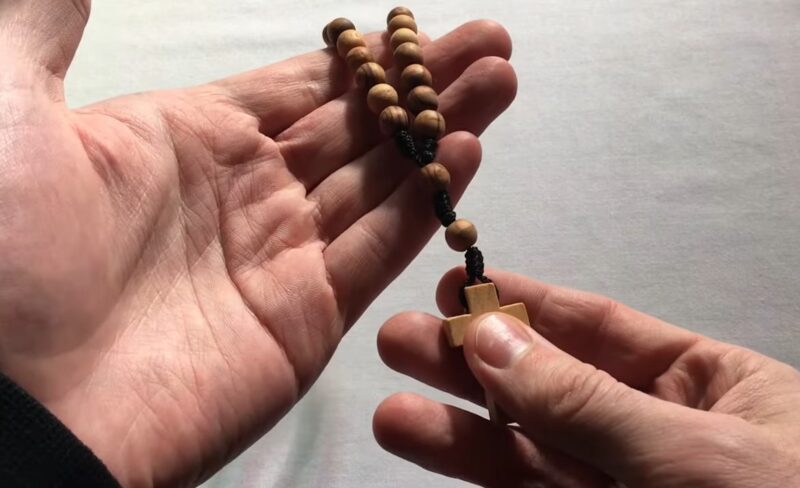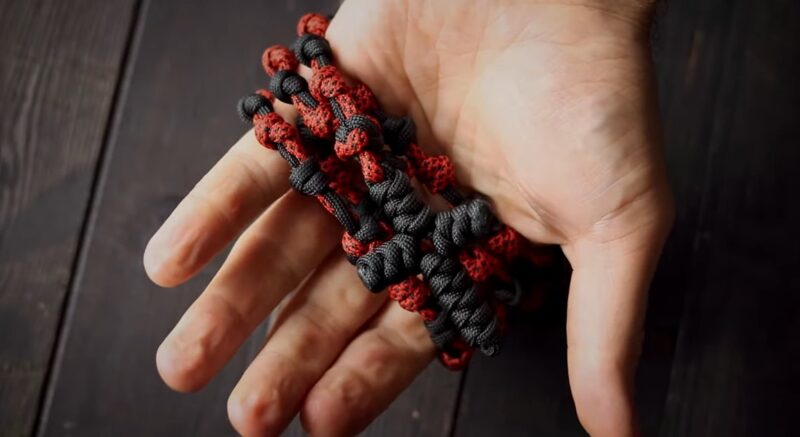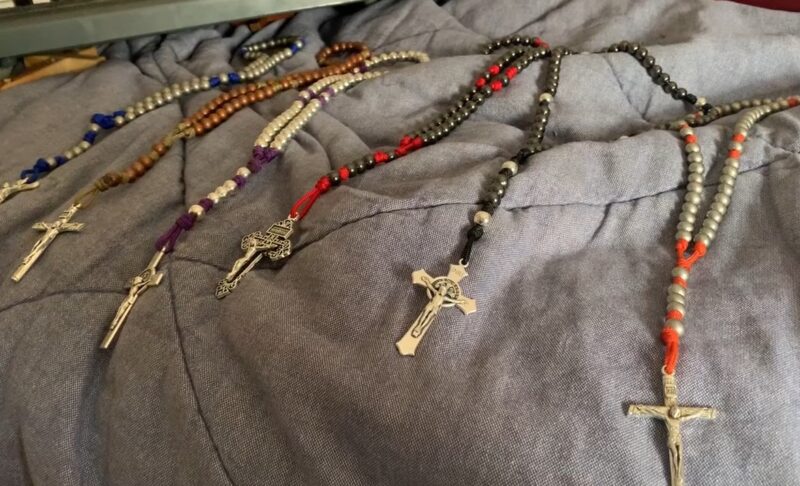The rosary is a cherished spiritual tool for millions, offering comfort, solace, and a tangible connection to the divine. But have you ever paused to ponder the significance of its structure?
Specifically, how many beads are there in a rosary, and why? Let’s talk about this mesmerizing circle of prayer.
Historical Origins
The rosary’s origins are as captivating as the beads themselves. Though closely associated with Catholicism today, similar prayer beads have been found across various cultures and religions.
A Universal Tool for Meditation

Prayer beads have been utilized by diverse religions for millennia. Their primary purpose: aid in meditation and repetitive prayer.
- Buddhism: Mala beads, usually made of 108 beads, help Buddhists count mantras.
- Islam: The Misbaha consists of 99 beads, symbolizing the 99 names of Allah.
- Hinduism: Japa malas also sport 108 beads for reciting mantras.
But how did the Christian world come to adopt this practice?
Birth of the Christian Rosary
The rosary, as we know it, has undergone evolution over the centuries. Initially, monastic communities would recite all 150 Psalms daily. As this was a challenge for laypeople, they started using beads or knots to count simpler prayers, like ‘Our Father.’
- Irish Penitentials: Early mention of repetitive prayer can be traced back to the 8th century.
- Desert Fathers: They used pebbles to keep track of their prayers in the early Christian era.
The rosary’s form and the prayers associated with it have been shaped by various saints, popes, and events throughout Christian history.
Structure

The beauty of the rosary lies in its structure, meticulously crafted to guide one through the life, passion, and glory of Christ. Let’s break down its various components.
The Overall Count
The traditional Catholic variation has 59 beads. These aren’t just random numbers. Each bead has a purpose and signifies a particular prayer.
- The Cross: Though not a bead, it’s where all prayers commence, with the Apostles’ Creed.
- The Invitatory Bead: Just above the cross, this solitary bead is for the ‘Our Father.’
- Next Three Beads: They stand for three ‘Hail Marys,’ generally for faith, hope, and charity.
- A Single Bead: Another ‘Our Father,’ which precedes every decade.
- Decades: Comprising 10 beads each for ‘Hail Marys,’ there are five decades in total.
Mysteries of the Rosary
Beyond beads, the mysteries are crucial to the rosary’s essence. They serve as meditative focal points.
- Joyful Mysteries: Meditated on Mondays and Saturdays. They reflect on the Annunciation, Visitation, Nativity, Presentation, and the Finding in the Temple.
- Sorrowful Mysteries: Tuesdays and Fridays. Focusing on Agony in the Garden, Scourging, Crowning with Thorns, Carrying the Cross, and Crucifixion.
- Glorious Mysteries: Wednesdays and Sundays. These encapsulate the Resurrection, Ascension, Descent of the Holy Spirit, Assumption of Mary, and her Coronation.
- Luminous Mysteries: Introduced by Pope John Paul II in 2002. Meditated on Thursdays, they highlight the Baptism of Jesus, Wedding at Cana, Proclamation of the Kingdom, Transfiguration, and Institution of the Eucharist.
The Significance

The rosary isn’t just about beads or prayers. It’s a spiritual journey, fostering a deeper connection with God and introspection.
A Spiritual Voyage
The rosary isn’t merely about vocal prayers. It is an invitation to meditate on key events in Christ’s life. As fingers glide from one bead to another, the mind is steered towards divine mysteries.
- Deepened Faith: By repeatedly contemplating on divine events, believers can strengthen their faith and feel closer to God.
- Inner Peace: The rhythmic nature of the rosary induces calm, helping one tackle life’s tumults.
Beyond Personal Prayer
While the rosary is often viewed as a personal prayer tool, its reach goes beyond individual spirituality.
- Community Bonding: Group recitations can foster community spirit.
- Intercessional Power: It’s believed that praying the rosary can intercede for world peace, heal the sick, and help souls in purgatory.
Variations Across Cultures

While the traditional rosary is deeply rooted in Catholicism, different Christian denominations and cultures have added their unique touch, tweaking the bead count or the way they’re used.
The Orthodox Prayer Rope
The Eastern Orthodox Church doesn’t use a rosary like the Catholic tradition but has a “prayer rope” known as the “komboskini” or “chotki”.
- Material and Shape: Typically made of wool, signifying the flock of Christ, and knotted in a specific way, often containing a cross.
- Bead Count: While there’s no standard number, 33, 50, 100, or even 300 knots are common, each knot signifying the Jesus Prayer.
The Anglican Rosary
Inspired by the Catholic rosary, the Anglican variation is a newer form of prayer bead practice that came into existence in the late 20th century.
- Bead Count: Contains 33 beads, symbolizing the years of Christ’s life on Earth.
- Structure: Four groups of seven beads, called “weeks,” with additional separate beads known as “cruciform beads.”
Making Your Own Rosary
There’s something profoundly personal about crafting your own rosary. Whether it’s selecting the beads or stringing them together, the process can be a form of prayer in itself.
Materials and Choices
When making a rosary, the choices are vast and can be tailored to personal preferences.
- Beads: Can be made of wood, stone, glass, or even seeds. The choice can reflect personal aesthetic or symbolic reasons.
- Spacers: Tiny beads or metal links can be used between the larger beads.
- Centerpiece and Cross: These can range from simple designs to intricate metalwork or carved pieces.
Crafting as a Spiritual Journey
The act of making a rosary can be as spiritually enriching as using it for prayer.
- Mindfulness: Assembling the beads, one by one, mirrors the repetitive nature of prayers, fostering mindfulness.
- Personal Connection: Crafting your own rosary can strengthen your connection to it, making your prayers even more intimate.
The Rosary in Modern Times
In today’s fast-paced digital age, one might wonder about the relevance of the rosary. Yet, its timeless allure persists and has even found a place in modern iterations.
Digital Rosaries and Apps
In an era where smartphones dominate, the rosary has adapted.
- Rosary Apps: Numerous apps guide users through prayers, complete with visual aids and meditative music.
- e-Rosaries: Recently, innovations like the “Click to Pray eRosary” have combined wearable tech with spiritual practice.
Contemporary Relevance
Even in contemporary society, the rosary’s significance hasn’t waned.
- Mental Well-being: In a world riddled with anxiety, the meditative aspect of the rosary offers a soothing balm.
- Symbol of Hope: For many, the rosary remains a tangible symbol of hope, solace, and divine connection.
FAQs
How did Rosary get the name?
The term “rosary” is derived from the Latin word “rosarium,” which translates to “rose garden” or “garland of roses.”
The rose is one of the symbols of the Virgin Mary, and the prayers of the rosary are often considered spiritual roses offered to her.
Are there any other types of rosaries apart from the ones mentioned?
Yes, there are other variations and adaptations depending on local customs, cultures, and even personal preferences. Some regions have specific additions or subtractions of beads, and some individuals design their rosaries based on personal spiritual significance.
How long does it typically take to pray a full rosary?
Praying a full rosary, which includes all five decades and the associated prayers, typically takes around 20 to 30 minutes. However, the duration can vary based on the individual’s pace, the level of meditation, and any additional prayers or intentions added.
How should one store or care for their rosary?
Rosaries are sacred items, and it’s a good practice to keep them in a respectful place, such as a pouch, box, or a dedicated drawer.
If made of delicate materials, it should be handled with care to avoid breakage. Some also choose to have their rosaries blessed, adding to their spiritual significance.
Can non-Catholics pray the rosary?
Absolutely. While it has its roots in Catholicism, its essence is meditative and reflective, making it accessible to anyone, regardless of their religious background.
Many non-Catholics find solace, comfort, and introspection in the prayers and mysteries of the rosary.
Are there any specific days or occasions particularly significant for praying the rosary?
While the rosary can be prayed any day, certain days have particular significance. For example, the month of October is dedicated to the Holy Rosary in Catholic tradition.
Also, specific feast days, like the Feast of Our Lady of the Rosary on October 7th, hold special significance. However, many devout Catholics pray the rosary daily, regardless of the date.
Final Words
The rosary, with its beads and mysteries, is more than just a prayer instrument. It’s a journey through history, cultures, and personal spirituality. Whether counted on fingers, beads, or digital screens, its essence remains unchanged – a pathway to the divine. It doesn’t matter if you’re a believer or simply curious; there’s no denying the profound impact of this circle of beads on human spirituality.
